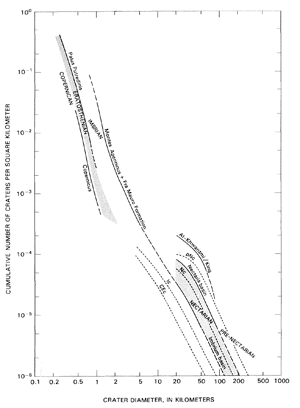
| Project Home | About the Scans | Browse Gallery | Image Map | Support Data | Resources | Ephemeris |
Featured Image - 07/15/2008
The Ages of the Moon
This spectacular Apollo 15 metric frame taken from lunar orbit by Astronaut Al Worden aboard the Apollo 15 Command Module Endeavour shows Mare Serenitatis. You can immediately see the difference between this relatively young mare surface and some of the other Apollo Featured Imagesk: This mare surface is smooth, and the craters are smaller. Even though this area of the Moon lacks some of the large impact craters and structural features seen elsewhere on the Moon, it's every bit as interesting. Lunar scientists can actually use images like this to determine the relative ages of lunar geologic units.
Figure 1. Apollo Image AS15-M-0576, showing a
region in western Mare Serenitatis [NASA/JSC/Arizona State
University].
How can we determine the age of a surface just from looking at a picture?
The process is time-consuming, but the results are worth it! It works like this: Because of the Lunar Orbiter and Apollo missions, we have some basic information about the stratigraphy of the lunar surface as well as accurate age dates obtained from the samples returned by the Apollo astronauts. The Apollo samples were collected by highly-trained astronauts on the lunar surface, so we can use their field experiences at the Apollo landing sites to relate the samples to specific geologic units on the lunar surface. We can then count the craters on these age-dated surfaces to compute the size-frequency distrubtion (the number and size of craters per unit area) of craters produced as a function of time. Comparing the absolute age of the Apollo samples to the size-frequency distribution in the age-dated regions near the Apollo landing sites has allowed lunar scientists to derive calibrated size-frequency distribution curves that can be used to estimate the relative ages of other lunar regions. In principle, one simply counts the number and size of impact craters on the surface in an unknown area of the Moon and compares it to one of the known regions. If the size-frequency distribution is the same, then an absolute date can be assigned to that particular area.
Figure 2. Cumulative crater size-frequency curves
for the some of the Moon's major time-stratigraphic and geologic units,
reproduced from Chapter 7 of Wilhelms (1987). The dashed curves are average
frequencies of impact craters of the pre-Nectarian (pNc), Nectarian
(Nc), Imbrian (Ic) and the Copernican/Eratosthenian periods (CEc) [United States Geological Survey].
Astronauts Harrison Schmitt and Gene Cernan sampled Mare Serenitatis directly during the Apollo 17 mission in 1972. Although most of the mare basalts they sampled were about 3.8 billion years old, using this crater counting technique it is now thought that the full range of basalt ages in Mare Serenitatis is 2.4 billion to 3.8 billion years old. Similar crater counts have been performed for all lunar maria, however the Apollo astronauts only sampled a handful of mare units. Unfortunately, the Apollo missions only visited middle-aged to ancient mare basalts so we do not know the absolute ages of the younger mare. If one assumes that the impact rate was the same from about 1 billion years to 3.8 billion years ago, age estimates can be made for these younger basalts. However, there is good reason to believe that the number of impacts has been declining since about 3.8 billion years ago. Thus, we must obtain samples of a few of the youngest mare basalt units to complete the age-dating job begun during Apollo.
The Apollo missions only photographed about twenty percent of the Moon at high resolution and only about half of that coverage is suitable for crater counting due to Sun angle differences (it is very difficult to spot craters in images taken near lunar noon). Right now the Japanese mission Kaguya is mapping the whole Moon at 10 meters (33 feet) per pixel and the Indian Chandrayaan-1 mission to be launched this fall will take images with twice as much resolution. Early in 2009 year the United States Lunar Reconnaissance Orbiter will enter lunar orbit and detect features down to a size of 50 cm (1.6 feet) as it scouts potential human exploration sites on the lunar surface.
For more information, read:
Wilhelms, D. E. (1987) The Geologic History of the Moon. United States Geological Survey Professional Paper 138. United States Government Printing Office.
Stöffler, D., Ryder, G., Ivanov, B. A., Artemieva, N. A., Cintala, M. J., Grieve, R. A. F. (2006) Cratering History and Lunar Chronology. Reviews in Mineralogy & Geochemistry, 60, pp. 519-596.
Tweet
|
|
Space Exploration Resources |
|
 LPI LPI
|

